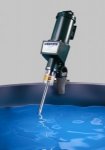ptonsparky
Tom
- Occupation
- EC - retired
New install.
Agitators that are a motor with an impeller. Picture a two blade prop on a boat.
Started 4 today and the amp draw is in the 32 vs 19-21 amp expected. The guys did raise one up so it operated just below the surface of the water vs the bottom of the tank. 10 amps. Flow of the liquid would be horizontal in the direction of the impeller. Could the position in the tank relative to the bottom be the problem? To simple?
Motors, wiring, Hz, voltage all good.
Agitators that are a motor with an impeller. Picture a two blade prop on a boat.
Started 4 today and the amp draw is in the 32 vs 19-21 amp expected. The guys did raise one up so it operated just below the surface of the water vs the bottom of the tank. 10 amps. Flow of the liquid would be horizontal in the direction of the impeller. Could the position in the tank relative to the bottom be the problem? To simple?
Motors, wiring, Hz, voltage all good.

